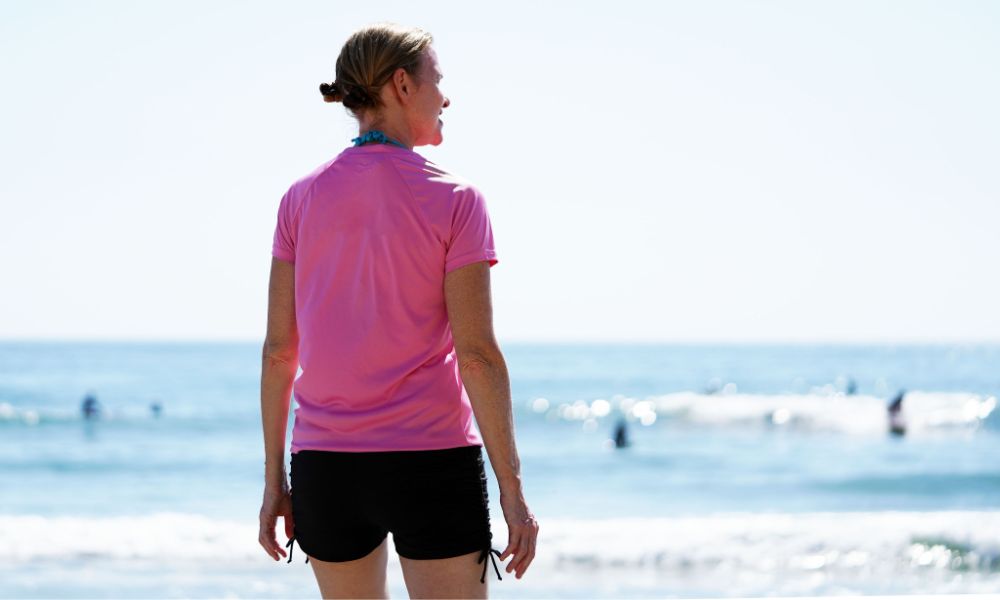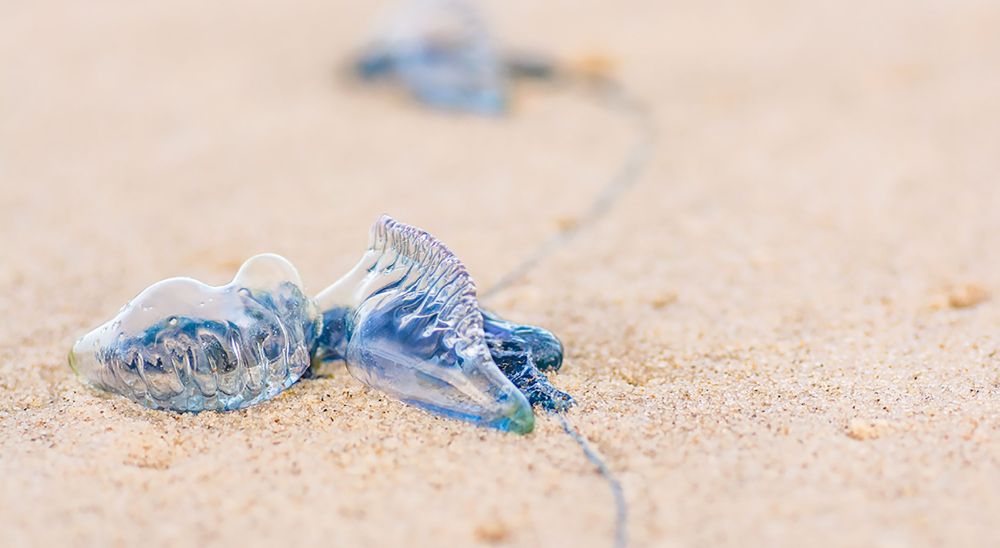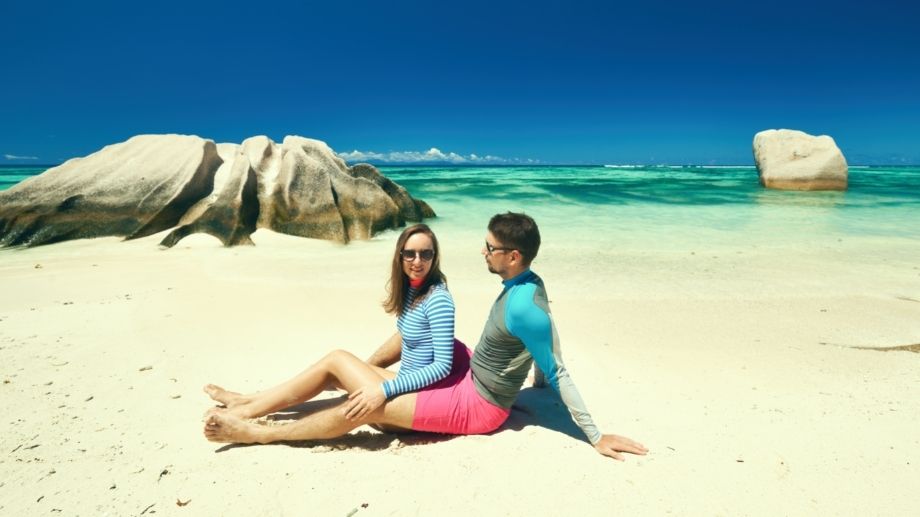Nothing is better than spending the day outside in the glorious sun swimming…that is until you come home sunburnt to a crisp. Aside from the layering on sunscreen, rash guards are a great way to protect your skin from the sun's harmful UV rays. But you may be wondering whether or not you can swim in a rash guard.
You can swim in a rash guard and it's perfectly normal to wear a rash guard to the pool or beach. Swimming in a rash guard will be more difficult than swimming without one as rash guards absorb water and weight you down, but they don't absorb as much water as t-shirts or other clothing. The UV protection is worth it though.
Rash guards are a great way to cover up under the sun while still allowing you to hop in and out of the water without any need to change or any need to constantly reapply sunscreen to your entire body.
If you haven't worn a rash guard before or you aren't sure when it's appropriate to wear it you've come to the right place.
In this article, I will discuss why it is socially acceptable to swim in your rash guard, the pros and cons of doing this, and as well as which rash guards are the best to use.
Is It Socially Acceptable to Swim in a Rash Guard?
In today’s society, everyone is forever worrying about what others think, so let me be the one to tell you that wearing a rash guard while swimming is totally socially acceptable and highly recommended if you burn easily!
In fact, rash guards are more common today than they ever have been due to the fact that people are getting more sun smart.
Rash guards were made to be used as coverage from the sun while you are swimming and participating in other water-based activities, and they come in so many different designs and funky colors.
You will see many people wearing rash guards out at the beach, from surfers to children and even adults. There is no age limit when it comes to protection from sunburn and no age limit when it comes to wearing a rash guard.
If you wear a rash guard, no one will look twice and wonder why you're wearing it and it's highly unlikely anyone will ask you why you're wearing one. They are completely normal to wear for all watersports.
So the next time you’re heading out to swim in the hot sun, don’t be scared to rock that rashie!
The Pros of Wearing a Rash Guard While Swimming

There are so many pros to wearing a rash guard while you are swimming that it almost feels like it doesn’t make sense not to wear one. This is especially true if you're particularly sensitive to the sun’s rays and burn easily.
This is why you'll often see kids wearing rash guards and people with fairer skin wearing them.
Protection from UV rays
The main reasons people choose to swim in a rash guard is because of the protection offered from the sun’s harsh UV rays. Pretty much all rash guards can come with an Ultra Violet Protection factor (UPF).
This is a special type of sun-repellent coating that has been applied to the material of the rash guard, providing the swimmer with ultimate protection from the sun's harmful UV rays. Some of these rash guards can come with a UPF rating of 50+.
A rash guard is great to use when swimming because it can become difficult to keep reapplying sunscreen when you’re in and out of the water all day. A rash guard is a better option than a t-shirt as it absorbs less water than regular clothing does so it will bog you down less and the material won't stretch as much.
Just remember to still use sunscreen on parts of your body that aren't covered by your rash guard.
Protection from chafing and skin irritation

Wearing a rash guard while swimming not only protects your skin from getting sunburnt but they also provide protection from any chafing and skin irritations.
This usually occurs doing things like surfing, where your stomach and ribs rub up against the board when you are paddling.
If you've ever ridden a foam surfboard without a rash suit, wetsuit or some sort of protection then you'll be familiar with the rashes and grazes you get from the board. This is probably why they call them rash shirts in the first place.
Provides warmth
While most rash guards don't provide any warmth, there are some that you can purchase than have insulation like a wetsuit that will keep you warmer than not wearing a rash shirt.
Adding that extra layer of coverage on top of your swimsuit while you swim will give you that little bit of warmth when you plunge into cold water.
Protection from sea creatures

If you swim in the ocean, often you’ll know that sometimes you might swim into jellyfish, blue bottles and other small critters that can cause skin irritation.
I still remember the day I got stung by 5 blue bottles in a single day. I was shaking from all the poison running through my body, but luckily I was ok.
Rash guards are a great way of adding an extra layer of protection from these creatures. While they don’t completely prevent you from getting stung or bitten, they do provide you with a lot more protection than just a swimsuit would.
Rash guards dry quickly
Another benefit of wearing a rash guard while you swim is that they dry very quickly in between swims, so you don’t have to pull it on and off and once you get out of the water it'll dry just as quickly as your board shorts of swim suit.
Compare this to a regular t-shirt and these absorb so much water that they can stretch and take an extremely long time to dry once you're out of the water.
The Cons of Wearing a Rash Guard While You Swim
There are a couple of cons to wearing a rash guard while you swim. But in my opinion, none of these are reasons to not wear a rash guard, unless you're doing a race where speed is extremely important.
Rash guards absorb water and make it harder to swim
The major downside of rash guards is that they do absorb water and weigh you down when you are swimming.
This is not a big deal when it's a day at the beach or the local pool and you're just splashing around having a bit of fun. But if you're doing some serious swimming and doing laps, long distances or a race then a rash guard will slow you down and make swimming more tiring.
People swimming long distances often wear trisuits or specific wetsuits designed for swimming that won't slow you down.
Ill-fitting rash guards can be cumbersome
Another con to wearing a rash guard when swimming is that ill-fitting rash guards can be uncomfortable and cause chafing, especially around the underarms seams.
A rash guard that is too loose can be really annoying. This usually happens when the rash guard is too old and has become extremely stretchy. If this happens it usually means it's time to replace your rash guard.
Be sure that you get the correct fit of rash guard for your body type.
The Best Rash Guards for Swimming

The best type of rash guard to use when swimming is the tight-fitted short or long sleeve rash guards.
The short sleeves make it easier to swim in if you’re doing some serious swimming or surfing and the long sleeve rash guards provide the ultimate protection from the sun.
You want your rash guard to be tight-fitting when you are swimming, as this creates less resistance and drag.
When choosing your rash guard, it is important to check out the stitching on the seams of the rash guard. Sometimes if the stitching is overlapping, it can cause irritation when you wear the rash guard.
Rash Guard or Swimsuit?
While swimming in rash guard may be socially acceptable, you may not want to cover up the next time you’re at the pool or beach, and that’s fine.
If you don't want to learn more about whether a rash guard or just a swimsuit is better, check out my article on rash guards vs. swimsuit.




